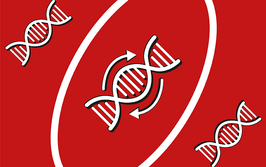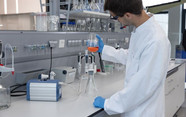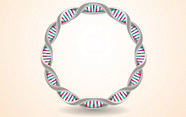Opening Up Environmental Analysis
How microfluidic paper analytical devices will make testing for the presence of toxic chemicals in air or water as simple, ubiquitous and inexpensive as measuring the temperature.
Airborne particulate matter (PM) is dangerous to humans, and represents a significant source of exposure because of its ubiquity and chemical complexity. Tens of thousands of compounds ranging from relatively harmless (for example, Cl- and Na+) to toxic (for example, polyaromatic hydrocarbons) have been identified in PM studies. Airborne metals (for example, copper, chromium, and nickel) are also common in PM and are consistently identified as contributing factors to daily morbidity and mortality. Yet, despite the relatively high rates of such diseases, our inefficient paradigm for assessing exposure has remained relatively unchanged for the past 25 years. We still do not fully understand, mechanistically, how PM (and its chemical constituents) adversely affects the body, nor do we understand which of the thousands of sources of PM should be targeted for reduction to improve health.
A range of problems need to be confronted. Currently, exposure monitoring relies too much on single stationary sites, analytical instrumentation that is restricted to the benchtop, and analytical techniques that are time-intensive and prohibitively expensive for evaluating individual exposures. Moreover, collected samples are rarely analyzed in the field, but instead are shipped to a central laboratory for analysis. The consequence is that the time from sample collection to reporting – or hazard communication – is typically several weeks. On top of that, processing can cost over $100 per sample. There is an urgent need for alternative monitoring solutions that are more affordable, timely, and user-friendly.
Microfluidic paper analytical devices (or µPADs), an old technology repurposed in 2007 by the Whitesides group at Harvard, is making a comeback as a new, low-cost strategy for analytical measurements (see “Using Simplicity”: tas.txp.to/0714/simplicity). This new class of sensors is designed for chemical analysis at the point-of-need. These sensors overcome restrictions posed by more expensive and complicated analytical techniques, namely user-friendliness, portability, and expense. Instead of relying on active pumping, samples in µPADs are processed passively through capillary action in common filter paper. Channel patterns printed onto paper generate circuits that restrict flow to defined regions, allow chemical reactions to take place in a well-defined manner, and cost pennies per sample. Because of their advantages, µPADs are making waves as an inexpensive alternative to traditional exposure assessment techniques.
Paper-based analytics may challenge the longstanding belief that scientific research must be left to the scientific community, particularly in the field of environmental science. To this end, collaborative efforts are already being aided by volunteers who donate their time and resources to make distributed measurements for large-scale environmental projects. The advent of this ‘citizen-science’ represents a promising resource for public and environmental health research. Community-based monitoring initiatives are becoming increasingly significant and impactful in the scientific community. For example, the “Click to Cure” program (www.clicktocure.net) uses crowdsourcing to sort through enormous banks of culture slides (viewable online) for cancer cell phenotyping. Another initiative, the Foldit program (http://fold.it/portal/), lets computer gamers (most with no biochemistry background) help design protein markers for viruses. To date, gamers have assisted with the design of thousands of proteins, a feat that has saved researchers precious time and expense.
However, examples of citizen-science projects in the field of public and environmental health are less prevalent, largely due to a lack of sensor technologies that are inexpensive and easy for public use. Thus, the development of new and inexpensive sensors for environmental pollutants has great potential for citizen-science to improve public health through distributed measurements that can lead to further outreach, advocacy, and education.

David Cate attended the University of Washington in 2005 where he received his bachelor’s degree in Bioengineering. From there he moved south to the University of Colorado where he developed polymer microfluidic technology for sorting single mammalian cells under the direction of Ralph Jimenez. He then ventured 50 miles north to Colorado State University to pursue his doctoral degree under Chuck Henry and John Volckens. “The techniques used for personal exposure assessment are beginning to change, and I hope we can contribute in a meaningful way to this exciting field.”

John Volckens is an Associate Professor of Mechanical Engineering and Environmental Health Sciences at Colorado State University. “Growing up with asthma made me very sensitive to my environment, especially to air pollution, which is why I work on these problems today.” His research interests involve human exposure to airborne particles, aerosol measurement, and air pollution-related disease. He received a PhD from the University of North Carolina at Chapel Hill in 2003 and then went on to Postdoc at the US EPA's National Exposure Research Laboratory in Research Triangle Park, NC.

Prior to joining the Chemistry Department at Colorado State University in 2002, Chuck Henry was an Assistant Professor at Mississippi State University. Chuck’s research interests lie in the general fields of chemical separations and “lab-on-a-chip” devices. His group is specifically interested in the development of microfluidic devices for rapid diagnostics in biomedical application and point-of-measurement analyses for environmental samples. A second area of research interest is in physical protein stability. In this research area, second viral coefficients for proteins are measured using a novel chromatography technique. Trends are then correlated with protein and physical stability. Projects in this area are largely performed in collaboration with biotechnology and pharmaceutical companies.

















